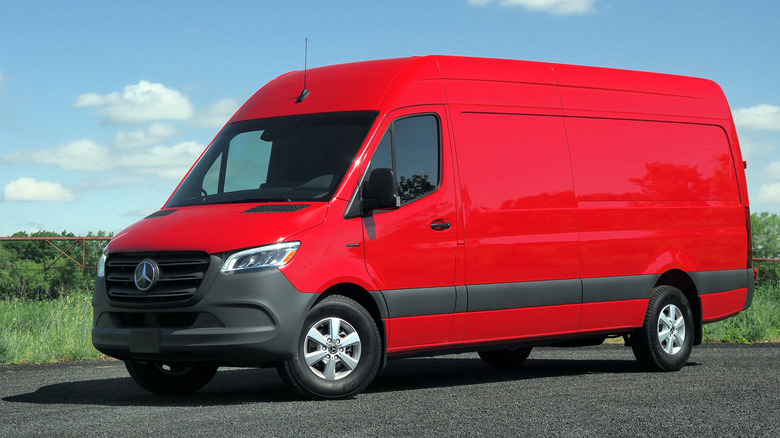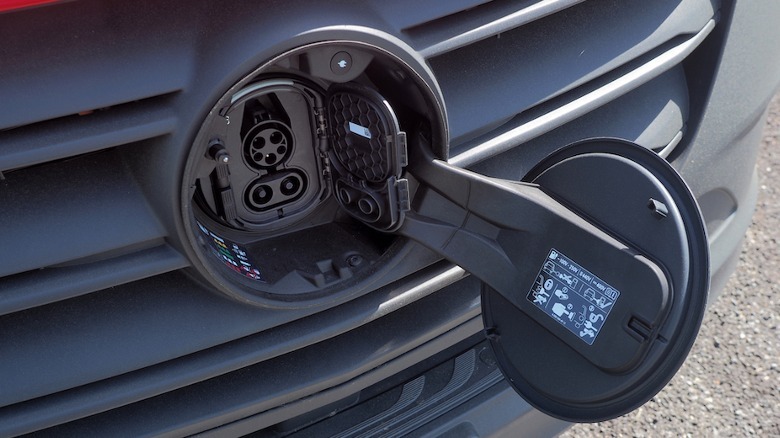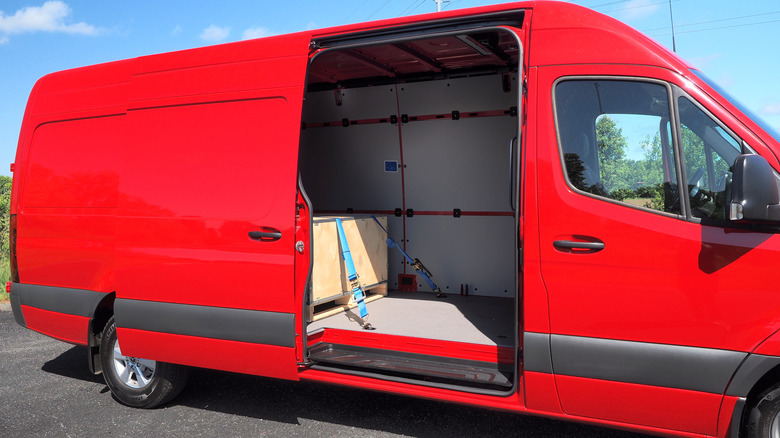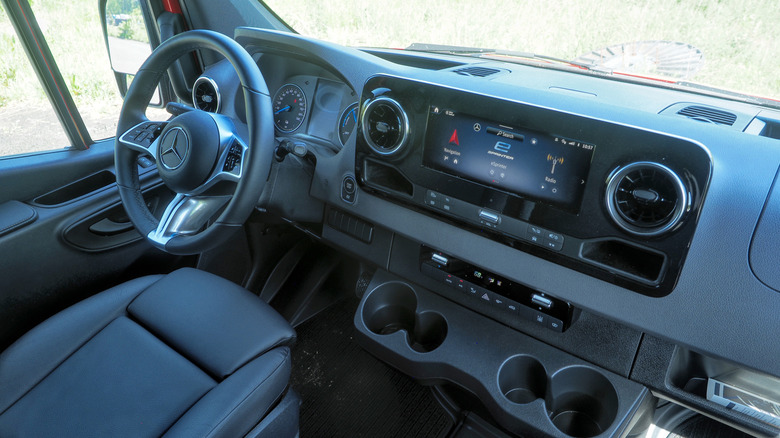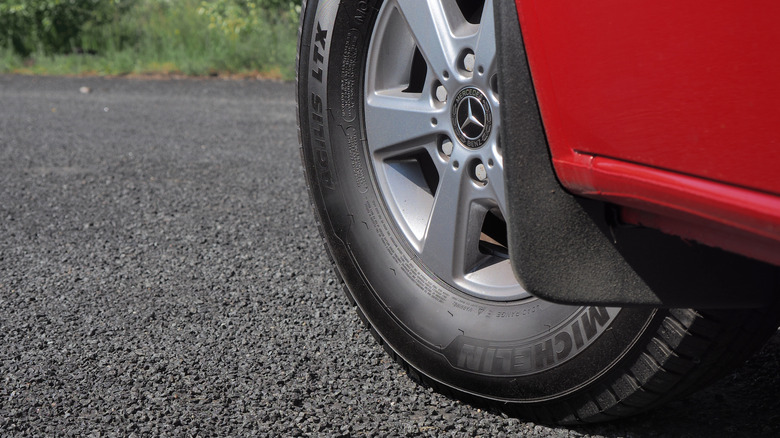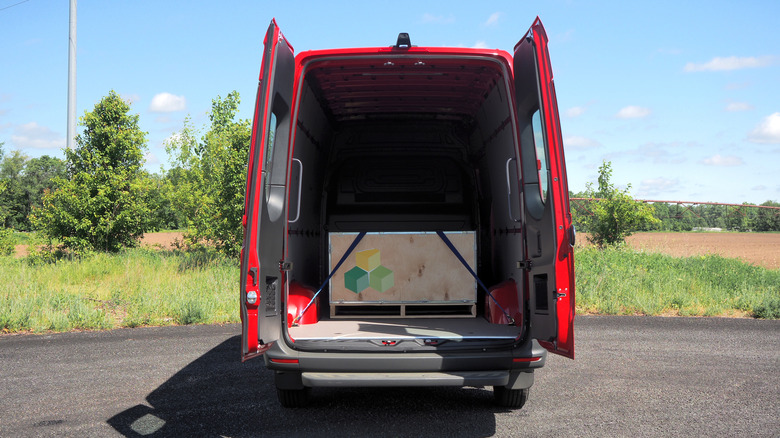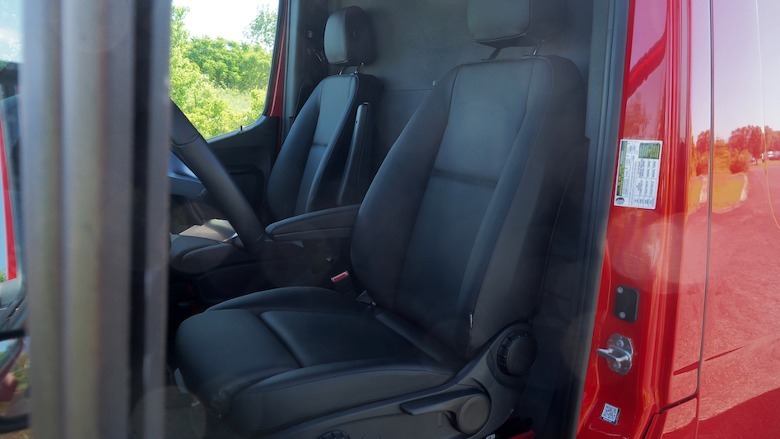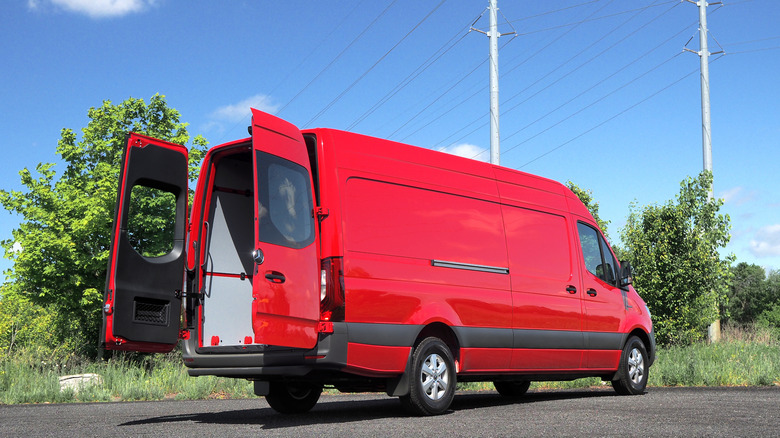Driving The Mercedes eSprinter Could Convince You That Electric Vans Are The Future
Auto enthusiasts may be skeptical when you tell them Mercedes-Benz already sells a fully-electric two-seater, but that's just because they're not thinking big enough. The eSprinter may not be the electric SL that many would-be California cruisers have been hoping for, but the EV version of Mercedes' big van is arguably even more important. And, as several days behind the wheel — including a near-mandatory trip to the local recycling facility — demonstrated, there are plenty of reasons why we should all be crossing our fingers that more vans ditch internal combustion.
While Mercedes' three pointed star may be associated first with luxury cars, its vans have been a rising success in recent years. Sales were up 15% in the U.S. during the first quarter of this year, and while Sprinter isn't the only commercial model — there's also the smaller Metris — its variants dominate the range.
Launching this year, the eSprinter is the first of the line-up to eschew internal combustion engines (ICE). Instead it has either a 100 kW or 150 kW electric motor driving the rear wheels, powered by up to a 113 kWh battery, with a quoted range of up to 273 miles (albeit on the WLTP cycle, which is usually more generous than the U.S. EPA's testing). Though Mercedes is targeting it at commercial customers, who might otherwise be looking to a Ford eTransit or Brightdrop ZEVO, it's not hard to see less business-minded buyers being curious, too.
No shortage of cargo space
Heads do not turn when the eSprinter drives past, even in bright Sunset Red. At over 23 feet in length and nearly nine feet tall, it's certainly big, though that makes it about the same as Ford's electric Transit. The 488 cu-ft of cargo space is roughly on a par with the Ford, too (Mercedes would probably like me to point out the 0.7 cu-ft advantage the eSprinter wields), though the eTransit is rated for 3,330 pounds of payload versus the eSprinter's 2,624 pounds.
Mercedes promises significantly more range, mind, plus 4,100 pounds of tow capacity where the eTransit has no such rating. And, while I've yet to drive an eTransit myself, from behind the wheel of the eSprinter I suspect both electric vans deliver a far more enjoyable driving experience than their ICE counterparts.
I've driven plenty of ICE-powered vans over the years, and to call the driving dynamics typically underwhelming is an understatement. Agriculturally-loud engines, plenty of vibrations, and lackluster power delivery are all par for the course, generally wrapped up in a cheap and poorly-equipped cabin. That's not what you find in the eSprinter.
It feels — and drives — like an electric Mercedes
Instead, Mercedes' van feels a lot like, well, a Mercedes van. Recognizable switchgear from the affordable end of the automaker's car line-up, combined with niceties like its MBUX infotainment system on an available 10.25-inch touchscreen. That means the unexpectedly capable voice assistant, triggered by the "Hey Mercedes" wake-word, but also wireless Apple CarPlay and Android Auto.
The steering wheel feels like a Mercedes wheel — albeit one from a couple of generations of car ago — and can optionally be heated, to go with the standard heated driver's seat. You can even have a wireless charger, hardly unusual in the passenger vehicle world, but still a rarity in vans.
Putting your right foot down, meanwhile, is a grand reminder why EV drivetrains are so great. The 295 lb-ft of torque is mustered instantly, propelling the eSprinter ahead with an urgency at odds with any gas van I've tried. Then I realized I had it set to Eco mode, switched to Comfort (there's also a miserly Max Range mode which felt borderline-alarmingly sluggish) and discovered it was even perkier than I had thought.
Dreaming of a quieter suburbia
Apparently doubting my ability to set up a last-minute shift as an Amazon delivery driver, Mercedes had strapped a 440 pound crate in the rear of the eSprinter to better represent how the van performs with a typical load. While the aforementioned — and currently non-existent — electric SL would probably handle better, the eSprinter had no issues. In fact, with the standard rearview camera mirror switched on, it was very nearly possible to ignore the scale of the van. While not quite "S-Class with air suspension" smooth, it wasn't the filling-shaking experience you might expect, either.
I'm not, personally, in the market for an electric cargo van, though I definitely hope to see more of them around. While there's certainly wind noise from the eSprinter's upright design, you notice that more because of the absence of a growling gas or diesel engine under the hood. With the rise in online shopping deliveries, accelerated by the pandemic, most neighborhoods have seen an uptick in traffic from zipping couriers. Trimming the soundtrack of that, and the emissions, would certainly help keep suburbia harmonious.
Firms specializing in local deliveries might well be those most willing to spend the $71,886+ on a 2024 eSprinter, too. A roughly equivalent diesel Sprinter, with the 170-inch wheelbase and high roof option, starts at $56,500. That's a not-insignificant delta.
Dreams of electric VanLife
Whizzing down the highway, though — and leaving sluggish ICE vans in my wake — I couldn't stop thinking about the potential for turning the eSprinter into an RV. The #VanLife hashtag may be overused on social media, but that doesn't mean there's not a huge cohort of people upfitting models like the Sprinter to roam the nation.
Mercedes isn't currying favor among such an audience, at least not yet. With the same Sprinter Cargo layout as the ICE version, though, it's not difficult to imagine EV early-adopters flocking anyway. Mercedes has an upfitting-focused Expert Solutions division, in fact, generally focused on using ICE-powered Sprinter and Metris vehicles, but there's no particular reason why those solutions shouldn't apply to the electric van, too.
It's not to say the eSprinter would be the perfect RV base for every camper. As Ford said when it launched the gas-only Transit Trail in late 2022 — its blank canvas for RV outfitting — the absence of an all-wheel drive eTransit limited its options, while total range was also a concern.
Not for every business, but a lot to like nonetheless
Ford also insisted, though, that it wasn't counting an electric Transit Trail out in future. So while the eSprinter may not be a range king itself — DC fast charging could take it from 10-80% in around 42 minutes, Mercedes says, a fair wait if you're trying to get back to your delivery route, but not so bad if your campsite has a fast charger nearby — it does at least have the tow rating that the eTransit lacks (another reason Ford decided it wasn't ready for Transit Trail duties). Considering, too, that one of the first thing most RV projects do is install a sizable battery pack to power camping equipment, an electric van's existing big battery suddenly looks a lot more appealing.
Recreation isn't going to be the eSprinter's primary purpose, certainly. Yet it's a reminder that, while the flexibility of filling up at any gas station is a boon for traditional, internal combustion vans, electrification polishes off a lot of the other rough edges such vehicles still suffer from.
As a driver, yes, I'd rather have an electric Mercedes two-seater that was a touch more sporty (I'd be willing to sacrifice a fair chunk of the eSprinter's cargo space for that, too). As someone hoping that the convenience of home delivery can coexist with cleaner air and quieter neighborhoods, though, vans like the eSprinter represent a fascinating expansion of EV technology.
